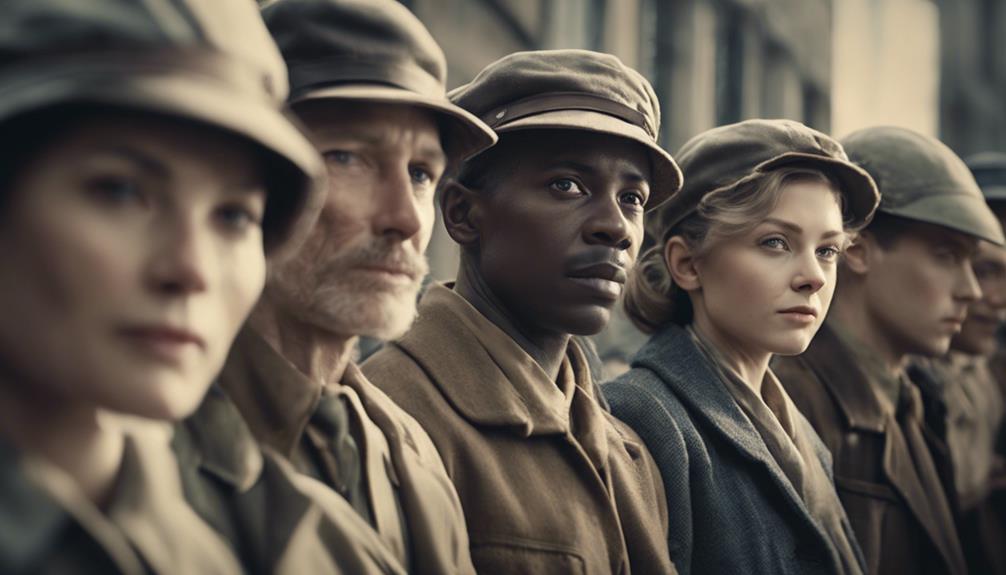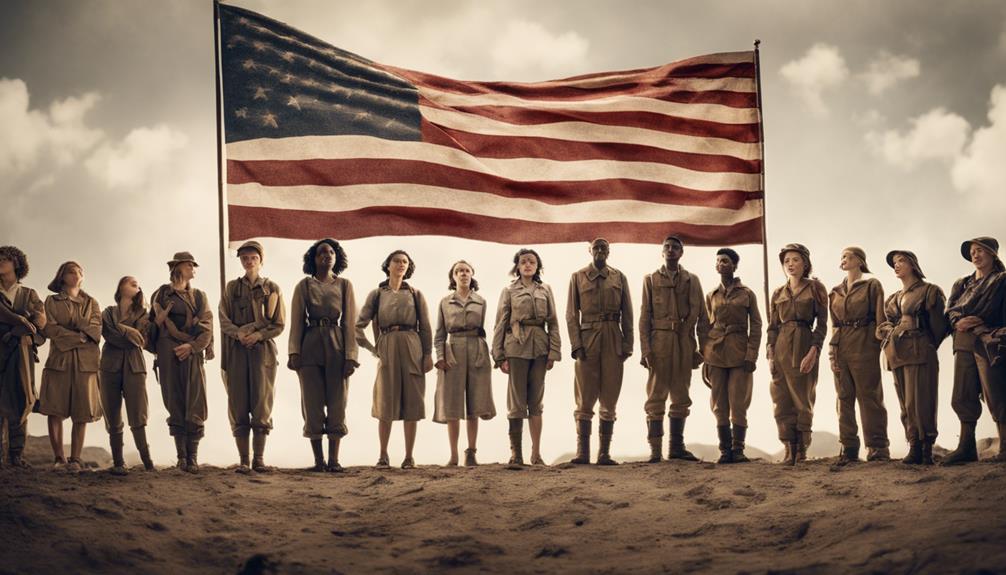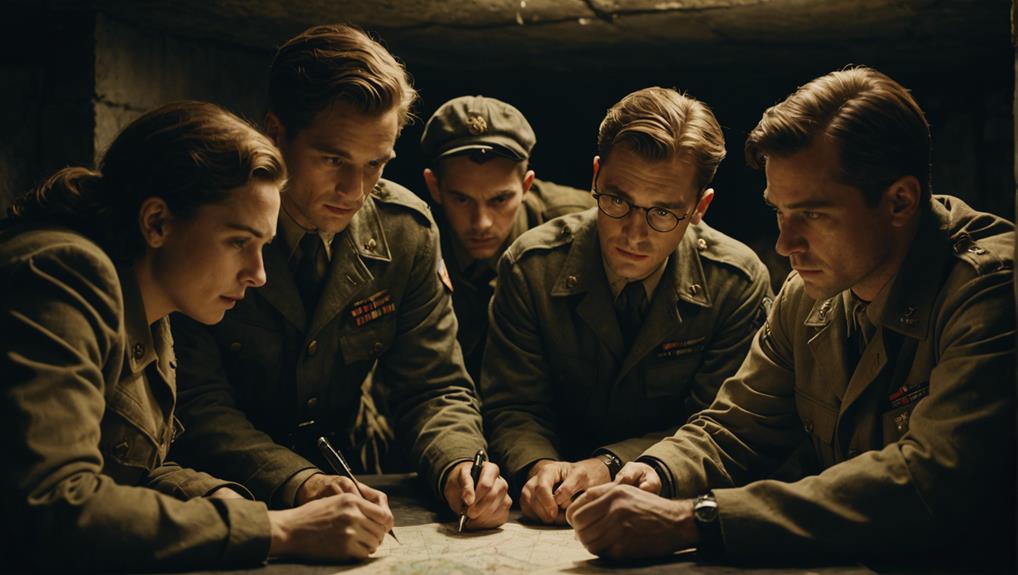In studying World War II resistance movements, you'll discover their courage and defiance against oppression that inspire. Ordinary citizens joining the fight shattered the belief that only trained soldiers made a difference. Unity in diversity showcased strength in numbers and shared values. These movements embody hope and resilience, inspiring future generations with unwavering spirit. Upholding moral values and fighting oppression were driving forces behind these brave actions. Their legacy continues to resonate, underscoring the importance of standing up for justice and human rights. The impact of collective action against tyranny is truly remarkable.
Historical Context of WWII Resistance Movements
During World War II, the historical context of resistance movements arose in direct response to the Nazi invasion of European countries. The German occupation of various nations sparked the formation of resistance groups across Europe. These groups, comprised of both civilians and armed fighters, banded together to oppose Nazi rule and fight against the oppressive regime.
Their acts of resistance ranged from publishing underground newspapers to actively aiding the Allies in their fight against the Axis powers. The World War II resistance movements played a crucial role in undermining Nazi occupation, disrupting enemy operations, and providing valuable intelligence to the Allies.
Support for these brave resistance fighters came from countries such as the United States, the United Kingdom, and the Soviet Union, who recognized the importance of these groups in the larger war effort. The courage and determination of these resistance fighters continue to inspire generations with their unwavering commitment to freedom and justice.
Acts of Courage and Defiance
Inspired by the courageous defiance of ordinary individuals risking their lives for freedom, the acts of bravery demonstrated by members of World War II resistance movements stand as powerful proof to the spirit of resistance against tyranny.
From the French Maquis to the organized resistance movements in Nazi-occupied territories, these groups embodied unwavering bravery in the face of oppression. Facing extreme danger, they clandestinely sabotaged enemy operations, rescued persecuted individuals, and gathered intelligence vital to the Allied cause.
The bravery displayed by these resistance fighters served as a beacon of hope for all who endured the harsh realities of occupation. Their defiance against the ruthless regime of Nazi Germany showcased the indomitable spirit of those who refused to submit to tyranny.
Through their actions, they continue to inspire future generations to stand up against oppression and fight for the values of freedom and justice. The legacy of their courage lives on as a proof to the resilience and strength of ordinary people in the face of extraordinary challenges.
Mobilization of Ordinary Citizens

Resistance movements in World War II mobilized everyday individuals, rallying them to actively oppose oppressive regimes and fight for freedom and justice. Ordinary citizens, often facing grave risks, joined these movements driven by a shared desire for liberation from tyranny. These movements exemplified the strength of collective action, demonstrating that when ordinary people unite, they can effect powerful change.
Through mobilization, regular citizens became key players in intelligence gathering, sabotage operations, and providing vital support to Allied forces. Their involvement shattered the notion that only trained soldiers or officials could make a difference in wartime.
The participation of ordinary citizens in resistance groups highlighted the resilience and determination of everyday individuals in the face of adversity. Their actions not only contributed significantly to the war effort but also served as a proof of the impact of grassroots movements in challenging oppressive regimes and standing up for what's right.
Symbolism of Collective Action
You see, the symbolism of collective action in World War II resistance movements is profound. It shows how unity in diversity brings strength in numbers, enabling ordinary people to stand together against oppression.
This solidarity highlights the power of coming together to confront tyranny and injustice head-on.
Unity in Diversity
The collective strength found in the diverse unity of World War II resistance movements during the era of Nazi occupation showcases the power of solidarity and collaboration in the face of oppression.
United against a common enemy, resistance fighters from diverse groups such as civilians, soldiers, and intellectuals banded together in acts of collective action to defy Nazi occupation.
This unity in diversity transcended boundaries of nationality, ethnicity, and social status, emphasizing shared values and beliefs.
The resilience and determination of these individuals serve as a poignant reminder of the impact that collective action can have in the fight against tyranny and injustice.
World War II resistance movements stand as a demonstration of the strength that arises when people come together for a common cause.
Strength in Numbers
Symbolizing the strength found in unity and collaboration, the collective action of individuals in World War II resistance movements serves as a powerful affirmation of the impact of solidarity against oppression.
The resistance forces, including the Free French and those in occupied territories like the Soviet Union, exemplified the power of working class solidarity in standing up against the Nazi regime. By coming together in large numbers, these groups showcased the effectiveness of organized resistance in challenging oppressive forces.
The unity and coordination among resistance members not only demonstrated their courage and determination but also inspired others to join the fight for freedom and justice.
The symbolism of collective action highlighted how ordinary individuals, when united for a common cause, can make a significant impact in the face of tyranny.
Solidarity Against Oppression
How can collective action against oppression serve as a beacon of hope and inspiration in times of tyranny and injustice?
During World War II, resistance movements like the Partisan resistance and Communist Party exemplified solidarity against oppression through armed resistance. The courage displayed by individuals standing together in the face of overwhelming odds symbolized the power of collective action.
These groups showcased the strength of unity and community, highlighting the determination of ordinary people to resist oppressive regimes. The symbolism of their solidarity lies in inspiring hope, defiance, and the belief in effecting change through unity.
The collective efforts of these resistance movements continue to serve as a reminder that courage and solidarity can overcome even the most challenging circumstances.
Legacy of Hope and Resilience
Embodying unwavering hope and resilience, World War II resistance movements stand as proof of the strength of the human spirit in adversity. The French resistance, the Warsaw Ghetto uprising, and various movements across Eastern Europe defied the brutal Nazi rule, inspiring generations with their courage. These resistance fighters, ordinary individuals pushed to extraordinary acts, left behind a legacy of hope, showing that even in the darkest times, light can shine through.
Their legacy of hope continues to resonate, reminding us of the power of unity and determination in the face of tyranny. The bravery and sacrifices made by these individuals serve as a beacon of inspiration, showcasing the indomitable spirit of those who refuse to bow down to injustice. Their stories highlight the resilience of the human soul, emphasizing that even in the most challenging circumstances, the flame of hope can never be fully extinguished. The enduring impact of these movements underscores the timeless lesson that standing up for what's right is a cause worth fighting for.
Importance of Standing Up for Justice

When you look at the actions of those who resisted during WWII, you can draw inspiration from their unwavering commitment to justice.
Standing up against oppression isn't just an act of bravery, but a testament to the core moral values that define humanity.
The importance of fighting for what's right echoes through the sacrifices made by those who refused to bow down to tyranny.
Upholding Moral Values
Upholding moral values by standing up for justice was a driving force behind the courageous actions of resistance fighters during World War II in Western Europe. These brave individuals believed in the importance of defending human rights and fighting for justice, even in the face of grave risks.
Their moral convictions led them to join underground movements and engage in acts of resistance against oppressive regimes. The unwavering belief in standing up for what's right fueled their courage and determination, inspiring others to follow suit.
Despite the dangers involved, the commitment to upholding moral values and principles of justice motivated these resistance members to take a stand and make a difference during one of the darkest periods in history.
Fighting Against Oppression
Standing firm against oppression is a tribute to the unwavering commitment to justice and freedom exhibited by resistance movements during World War II. The defiance shown by those resisting the German occupation symbolizes the universal human desire for dignity in the face of oppressive regimes.
Individuals and groups risked their lives to stand up against injustice, highlighting the power of collective action in challenging oppression. The legacy of World War II resistance movements continues to inspire modern-day movements for equality, rights, and freedom worldwide.
Let these acts of courage and determination remind you of the importance of fighting against oppression and standing up for justice.
Conclusion
You simply can't ignore the power and impact of World War II resistance movements. They weren't just acts of rebellion, but symbols of hope and resilience that continue to inspire generations.
The courage and defiance shown by ordinary citizens in the face of tyranny is a reminder of the importance of standing up for justice. These movements aren't just historical moments, but beacons of light in a dark world, shining brightly for all to see.


